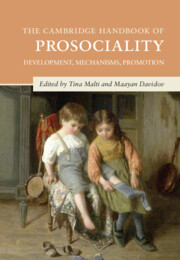Book contents
- The Cambridge Handbook of Prosociality
- Cambridge Handbooks in Psychology
- The Cambridge Handbook of Prosociality
- Copyright page
- Dedication
- Contents
- Figures
- Contributors
- Part I Development of Prosociality
- Part II Antecedents and Mechanisms of Prosociality
- 11 The Motives of Prosocial Behavior
- 12 Morality, Values, and Prosociality across Development
- 13 Emotions and Prosociality
- 14 Social-Cognitive Development and Early Prosocial Behavior
- 15 Temperament and Prosocial Behavior
- 16 Gender and Prosocial Development
- 17 Assessing Prosociality
- Part III Development of Prosociality in Context
- Part IV Applications
- Index
- References
17 - Assessing Prosociality
An Early Ontogeny Perspective
from Part II - Antecedents and Mechanisms of Prosociality
Published online by Cambridge University Press: 25 May 2023
- The Cambridge Handbook of Prosociality
- Cambridge Handbooks in Psychology
- The Cambridge Handbook of Prosociality
- Copyright page
- Dedication
- Contents
- Figures
- Contributors
- Part I Development of Prosociality
- Part II Antecedents and Mechanisms of Prosociality
- 11 The Motives of Prosocial Behavior
- 12 Morality, Values, and Prosociality across Development
- 13 Emotions and Prosociality
- 14 Social-Cognitive Development and Early Prosocial Behavior
- 15 Temperament and Prosocial Behavior
- 16 Gender and Prosocial Development
- 17 Assessing Prosociality
- Part III Development of Prosociality in Context
- Part IV Applications
- Index
- References
Summary
The research methods we use to assess prosociality in young children are the ultimate arbiter for our understanding of prosocial development. The theoretical conclusions we base on empirical data are nested, if not entirely rooted, in the ways in which we measure and statistically model children’s prosociality. This chapter focuses on early ontogeny and systematizes the landscape of research methodologies currently used to study prosocial development. It offers a critical reflection on some of the methodological and statistical constraints under which current research on prosocial development is being conducted. The chapter closes by arguing that new technological advances have paved the way for a more inclusive and systematic study of prosociality in the early years of development. Embracing these ongoing efforts will require a new kind of discussion about the ways in which we statistically model development and how we draw inferences about “significant” effects in early ontogeny.
- Type
- Chapter
- Information
- The Cambridge Handbook of ProsocialityDevelopment, Mechanisms, Promotion, pp. 335 - 358Publisher: Cambridge University PressPrint publication year: 2023



